Acoustic waves produced by pressure fluctuations in the turbulent exhaust region of differential mobility analyzers (DMAs) are radiated upstream, making the flow in the working region slightly unsteady and reducing DMA resolution. This claim is demonstrated in a variety of settings. First, a resonance has been observed in several DMAs where the resolution decreases drastically in a narrow range of flow rates. This resonance can only be acoustic, and must be excited by flow unsteadiness, which is only present downstream. Second, non-idealities observed in two very different DMAs are suppressed when they are operated under transonic conditions. This is consistent with the inability of acoustic waves to propagate upstream against a supersonic flow. Third, these non-idealities decrease when the turbulent exhaust region from which acoustic radiation would originate is not in direct sight with the DMA's working section. These findings suggest new strategies to achieve DMA resolving powers approaching 100 under subsonic conditions.
1. INTRODUCTION
In a recent study (CitationMartínez-Lozano et al. 2005), we have reported that the non-ideal transfer function width of a differential mobility analyzer (DMA; CitationKnutson and Whitby 1975) operating at subsonic flows decreased drastically under transonic conditions, attaining an almost ideal value near sonic speeds. We speculated that the nonidealities observed could be due to acoustic radiation from the exhaust system of the DMA back into its working section. The transonic resolution improvement observed would then be explained as due to the impossibility for these presumed perturbations to travel upstream against a supersonic flow (CitationFernández de la Mora et al., 2004). We noted, however, that this hypothesis did not rest on any published experimental or theoretical evidence indicating that the acoustic radiation levels from a typical exhaust system may have the large observed effects on ion classification. The objective of the present note is to provide that missing evidence in order to confirm the hypothesis previously advanced. Another objective is to suggest means to avoid or reduce this undesirable source of non-ideality without the need to run the DMA under transonic conditions.
2. EXPERIMENTAL TECHNIQUE
reproduces some of the data from (CitationRosser et al. 2005; Figure 8) on the full width at half height (FWHH) of the DMA transfer function as a function of the classification voltage V for two DMAs analyzing ions of fixed electrical mobility Z. The ion used is a convenient nanometer monodisperse mobility standard produced by electrospraying a solution of tetraheptyl ammonium bromide, and has an electrical mobility Z = 0.96 cm2/Vs (CitationGamero and Fernández de la Mora 2000). Our experimental technique records the current I(V) of sampled ions while scanning over DMA voltage V at fixed sheath gas flow rate Q and ion mobility Z. Such I(V) curves form narrow peaks, whose position and width we characterize by means of the peak relative width FWHH and the voltage Vp at its maximum. Each datum in represents one of these (Vp, FWHH) pairs, and the various points in the figure are for the same Z and varying Q.
FIG. 1 Full width at half height (FWHH) versus peak voltage for the transfer function of the DMA of CitationRosser et al. (2005) when classifying tetraheptyl ammonium ions. Note the resonance arising at about 410 volts, attributed to acoustic radiation.
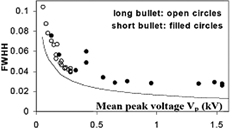
We should note that our measurement method based on a monomobile aerosol differs from the more commonly used tandem DMA approach. Because the transfer function is defined as the ratio of inlet to outlet ion concentration resulting from scanning over the variable ZV/Q, direct measurement of this function requires complete experimental control of the three variables Q, Z and V. Full control of Z independently of a complex and generally unreliable inversion procedure is only practical when using a monomobile aerosol. An attempt to measure a transfer function with a distribution of Z is akin to an effort to measure it in an unsteady flow, where Q is not fixed but is distributed over a finite range of values, with only its statistical properties known. Nonetheless, even in a technique based on strictly monomobile ions, in the presence of diffusion effects (diffusion broadening depends separately on the three variables Q, Z and V rather than the single group ZV/Q), one has to define carefully the transfer function. Our present definition is the one that suits our experimental technique, where Q and Z are fixed and V is varied. Scanning over Q at fixed V would lead to a different result, though the differences would be slight at small FWHH (provided that the aerosol to sheath gas ratios are kept constant, and the azimuthal symmetry and steadiness of the flow is preserved as Q is varied).
Note also that, although the peak voltage Vp is not a fundamental quantity, the dimensionless group Vpe/kT based on the thermal energy kT and the elementary charge e (our test ions are all monovalent, so that at room temperature kT/e ∼ 0.025 Volt) is a key predictor for Brownian diffusion broadening of the transfer function (CitationTammet 1970; CitationRosell et al. 1996; CitationFlagan 1999). This dimensionless voltage can, in fact, be expressed in terms of a Peclet number based on ion diffusivity flow speed and a characteristic dimension of the device.
3. ACOUSTIC RESONANCES IN DMAs AND THEIR EFFECT ON RESOLUTION
includes data for two DMAs, one relatively long, the other relatively short. For the short instrument, the general trend of a decreasing FWHH with increasing peak voltage Vp is drastically altered in the vicinity of a critical voltage of about 410 volts. This sharp departure from the generally expected trend under very specific flow conditions justifies referring to it as a resonance (CitationRosser et al. 2005). A large increase in FWHH can only be due to a drastic change of the flow away from its ordinary steady and axisymmetric state. This resonance cannot be due to a turbulent transition within the analyzing region, since the level of turbulence would increase at flow rates above the onset value. Resonant breakdown of the cylindrical symmetry of the flow cannot be precluded absolutely, but it would certainly be a very unusual phenomenon. The alternative hypothesis that this resonance is associated to unsteadiness of the flow is therefore almost unavoidable. The flow of sheath gas is, in fact, unsteady downstream from the working section of this DMA, as it is forced to turn twice by 90 degrees, leading to a separated annular jet that must immediately become turbulent and may very well be oscillatory. Turbulence itself involves unsteadiness, and the associated pressure fluctuations can propagate upstream in the form of acoustic waves. How much this radiated sound can affect DMA performance depends of course on its amplitude in the classification region. For purely estimative purposes, let us consider the simplest hypothesis that fluid particles are oscillating along the axis of the DMA with an amplitude ϵ (cm) in the vicinity of the aerosol sampling slit. Then, an ion with a mobility Z close to the classification value Z* would reach the sampling slit (at axial position z = L) under steady conditions. But under unsteady conditions it would instead reach the sampling electrode at an axial position oscillating within the interval [L–ϵ, L + ϵ]. Because the period of acoustic oscillations is much shorter than the response time of our electrical detectors, this oscillation cannot be directly seen in the amplitude of the collected ion current. But the corresponding relative half width of the transfer function would be at least ϵ /L. Acoustic waves can therefore decrease the resolving power of a DMA provided they have sufficient amplitude. Acoustic oscillations can also become resonant if the dominant driving frequency is in tune with a natural frequency of the internal DMA chamber, very much as in an organ pipe or in other resonators. In the case of an oscillating separated jet, hypothetically formed at the exit of the working section, its frequency of oscillation (the driving frequency) will evidently depend on the flow rate of the sheath gas through the DMA. Therefore, the possibility that this driving frequency will match the natural frequency of the cavity at a particular flow rate does indeed exist in principle. If such a resonance arises, the intensity of sound will increase, and so will FWHH. Such resonances are ubiquitous in flow systems such as rocket engines, where their intensity may be large enough to damage the structure. Acoustic resonances can therefore be expected to arise in the annular geometry of a DMA like that of CitationRosser et al. (2005), confined upstream by a screen and downstream by 10 symmetrically placed exhaust holes connected to a plenum chamber.
The resonance depicted in is in fact not exclusive of one DMA. Similar unpublished DMA responses had been seen earlier in our Yale laboratory with several models of the Herrmann DMA, as well as with a different variant of the Rosser DMA using a less slender inner electrode (CitationRosser et al. 2005). These observations therefore show that acoustic waves produced in the turbulent exhaust system of a DMA can propagate upstream and affect the resolving power of the instrument. Given that the effect of such acoustic waves can be so large under resonant conditions, it could be non-negligible even under non-resonant conditions.
4. SONIC SUPPRESSION OF ACOUSTIC RADIATION IN THE Río ARRIBA AND HERMANN DMAs
The singular observations of CitationMartínez-Lozano et al. (2005) already discussed provide further evidence in favor of the hypothesis that DMA resolution can be affected by acoustic radiation. We have extended their work with the Río Arriba DMA (CitationRamiro et al. 2003, Citation2004) by studying several other ions with mobilities larger than that of heptyl4N+, including those shown in with their corresponding electrical mobilities Z.
Table 1 Electrical mobility of the three ions used
a shows data on inverse resolution (measured by the ion relative full width at half height. FWHH) versus DMA voltage at the peak. The data for all the ions exhibit the same peculiar structure previously seen for heptyl4N+, with the obvious difference that the maximum voltage (corresponding to sonic conditions) depends on mobility, as does the resolution. The known scaling law for diffusion limited resolution gives
FIG. 2 Performance of the Río Arriba DMA (RA) with three different ions. Note the dip down to almost ideal behavior near the sonic point (rightmost datum for each ion). (a) FWHH versus voltage (volt); (b) FWHH/Z1/2 versus Re1/2, with Z in cm2/V/s.
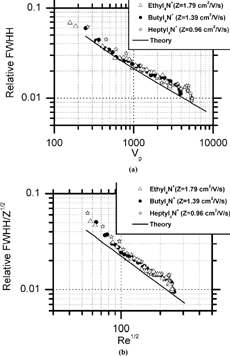
The interesting feature of this formulation lies in the fact that it separates the role of the flow field (both Reynolds and Mach number effects) on the right hand side of equation Equation2, and the ion size dependence on its left hand side variable. b reproduces the data from a in the variables suggested by Equation (Equation2) showing indeed that the non-idealities observed are strictly a function of the flow, while the dependence of FWHH on particle size is governed by the same 1/2 power dependence on D (or Z) as ordinary diffusion under steady flow. The 1/2 power dependence on Re is not preserved because the intensity of the radiation affecting FWHH is a function of Re.
The facts assembled so far do support the radiation explanation of the non-idealities observed. However, this transonic benefit is specific to a particular DMA. One could therefore argue that some other yet unknown transonic effect acting directly in the working section rather than downstream from it might be beneficial to DMA resolution. This objection, however, is incompatible with new observations to be described here on another transonic DMA. The instrument is a low resistance variant of the Herrmann DMA (CitationHermann et al. 2000). It has a wide inlet trumpet for laminarization, with an area ratio of 25. It has a cylindrical working section with a bullet-shaped inner electrode 11 mm in diameter and an outer electrode 18.6 mm in diameter. It incorporates a new rather long annular diffuser following the cylindrical working section, with inner and outer walls diverging from the symmetry axis at 4 degrees and 7 degrees, respectively. The diffuser exit area is 4.77 times the working section area, which would ideally permit a pressure recovery of 95%. The flow is then smoothly deflected to an annular exit channel oriented at 30 degrees away from the DMA axis, and is finally drawn through an exhaust system with almost no area reduction, reminiscent of those used to support turbomachinery components in aircraft motors.
This Long Herrmann DMA, its diffuser, and its peculiar exhaust design will be described in more detail elsewhere. For present purposes it suffices to say that the diffuser recovers 79% of the dynamic pressure at the working section. As shown in , choking is manifested by a saturation of the peak voltage of the monomobile ion heptyl4N+ upon increasing monotonically the pumping power. The DMA was powered with a pair of vacuum cleaner pumps, each connected to a variable voltage transformer.
FIG. 3 Mobility spectra for the tetraheptyl ammonium ion in the Herrmann DMA. While pumping power increases monotonically from left to right, the peak positions exhibit a saturation phenomenon indicating that sonic conditions have been reached. Vp is in volts.
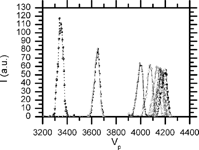
includes FWHH versus Vp curves for two different ions. It shows a monotonic decrease of FWHH with increasing voltages up to the maximum speed (and voltage) reached, corresponding to sonic conditions in the DMA. The best resolution obtained with heptyl4N+ is about FWHH = 1.4% (4.15 kV).5
FIG. 4 FWHH versus peak voltage for the Herrmann DMA, using either methyl4N+ ions (a), or ethyl4N+ (b). Vp is in volts.
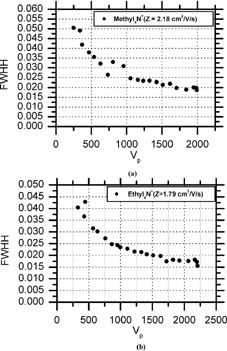
There are several noteworthy differences between the response of the Herrmann and Río Arriba DMAs. First, a sonic decrease of FWHH is evident in for both ions, but its magnitude is substantially smaller than in the Rio Arriba DMA (RA). The transonic effect becomes more evident by re-plotting the data of in the representation of , akin to that in b, but with the Mach number (in the working section) rather than the Reynolds number used in the horizontal axis. Increasing the Mach number in the vicinity of the sonic point (by increasing the downstream pumping power) leads to very small changes in flow rate, hence no improvement in ideal resolution. This expected saturation is confirmed by the rather modest change of FWHH between Mach numbers 0.6 and 0.9. However, a sharp increase in resolution is seen for the two ions at Mach numbers above 0.9. This is evidently not a Reynolds number effect (Re is almost fixed in this narrow range), but a transonic effect. The Mach number shown in this figure is inferred from the ratio between the pressure measured at the aerosol outlet slit and atmospheric pressure, under the assumption that the flow field between these two points is quasi-one-dimensional, isentropic and adiabatic.
FIG. 5 Resolution of the Herrmann DMA in a representation similar to that of b, separating the flow effects in the horizontal variable. This variable is now the Mach number in the working section, showing with greater clarity the transonic increase in resolution.
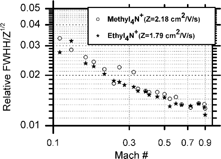
A second difference with the behavior of the Rio Arriba DMA is that, as seen in , the Herrmann DMA peaks are not symmetrical, but have a sharper tail at the high voltage end. This asymmetry is almost surely associated to a slight imperfection in the centering of the inner electrode, due to its great length (forced by the long diffuser). In a better centered instrument, FWHH would be substantially smaller than the 1.4% measured. Indeed, if we base FWHH on twice the width of the right portion of the peak, we obtain values of about 1% at the largest voltages.
A third difference can be identified from pressure measurements at the DMA throats (taken through the aerosol outlet slit line). At maximum pumping speed, these measurements show Mach numbers (based on the quasi-one-dimensional, isentropic and adiabatic assumptions) Ma = 1 and 0.9 for the Río Arriba and the Herrmann DMAs, respectively. The difference in speed is at first sight surprising given that both instruments are undoubtedly choked. The explanation of why the Herrmann DMA is choked while its working section is at Ma = 0.9 is that it reaches critical conditions downstream from the working section, probably at the entry point in the diffuser where the walls turn from cylindrical to conical. The net effects of this delayed sonic point are that the working section of the DMA is not transonic, but downstream radiation is still suppressed from all points except a brief segment immediately upstream of the bend in the diffuser. This region is almost surely laminar, so that no radiation from it is expected. Any observed sonic anomalies in the resolution cannot therefore be attributed to an unknown transonic effect acting in the working section (which is subsonic). There is now clearly a transonic effect acting downstream from the working section, and this effect is undoubtedly the suppression of downstream radiation. The question remains of why is the transonic anomaly so much weaker in the Herrmann DMA (H) than in the Río Arriba DMA (RA).
Our explanation involves a combination of two differences in instrument construction. First, H is partially shielded from radiation due to the presence of two curved regions between the exhaust system and the working section, while these two regions are under direct line of sight in RA. This would tend to give a better resolution in Herrmann when operating subsonically, and would therefore yield a smaller improvement in resolution at the sonic point (hence the smaller transonic anomaly observed). On the other hand, RA is better centered than H, and this advantage tends to cancel its radiative disadvantage in the subsonic region. The net result is the observation that both DMAs have comparable resolving powers outside the transonic region, but RA is clearly superior near the sonic point. On the other hand, once the mechanical imperfection of H is removed (by considering only at the right hand side of the peak), both devices reach comparable resolution also in the transonic region. Indeed, the asymmetry of the Herrmann peaks in becomes more manifest at the highest speeds, confirming that there is indeed a steepening of the right tail as sonic conditions are approached. The narrowing of the peaks near the sonic point is more noticeable in the data for the smaller ions, where choking occurs at smaller flow rates, and hence at larger values of FWHH at which the slight geometrical imperfection of the DMA has a smaller effect.
5. CONCLUSIONS
Observations on several subsonic and transonic DMAs show that acoustic waves originating in the turbulent exhaust region can propagate upstream into the working region and may decrease instrument resolution. This non-ideality is cancelled under transonic conditions. Strategies to minimize the source of radiation and to limit its efficiency of transmission into the working section should be considered. In particular, one or several turns in the exhaust gas path appear to be beneficial.
Acknowledgments
We are grateful to the Spanish Ministry of Education and Science through grant DPI2001-0689 for their full support of P. M-L S during his visit to Yale, to RAMEM (Madrid) for their design and fabrication of the Ri´o Arriba DMA, and to NanoEngineering Corporation (Florida) for their loan of the diffuser and exhaust components for the Herrmann DMA. The latter element was designed in collaboration with Mr. Jerzy Kozlowski (AMPOL TOOL, New Haven, CT, USA).
REFERENCES
- Fernández , d e , la Mora , J. , Labowsky , M. J. , Schmitt , J. J. and Neilson , W. Method and Apparatus to Increase the Resolution and Widen the Range of Differential Mobility Analyzers (DMAs), United States Patent . 6,787,763 . 2004, September 7 .
- Flagan , R. C. 1999 . On Differential Mobility Analyzer Resolution . Aerosol Sci. Technol. , 30 : 556 – 570 . [CSA]
- Gamero-Castaño , M. and Fernández de la Mora , J. 2000 . Mechanisms of Electrospray Ionization of Singly and Multiply Charged Salt Clusters . Analytica Chim. Acta. , 406 : 67 – 91 . [CSA] [CROSSREF]
- Herrmann , W. , Eichler , T. , Bernardo , N. and Fernández de la Mora , J. 2000 . Turbulent Transition Arises at Re ∼ 35000 in a Short Vienna-Type DMA with a Large Laminarizing Inlet. Abstract presented to the annual meeting of the AAAR . October 6–10 2000 , St Louis , MO .
- Knutson , K. O. and Whitby , K. T. 1975 . Aerosol Classification by Electric Mobility: Apparatus, Theory, and Applications . J. Aerosol Sci. , 6 : 443 – 451 . [CSA] [CROSSREF]
- Martínez-Lozano , P. and Fernández de la Mora , J. 2005 . Resolution Improvements of a Nano-DMA Operating Transonically . J. Aerosol Sci , in press[CSA]
- Ramiro , E. , Ramiro , F. , Sanchez , M. , Lazcano , J. A. , De Juan , J. and Fernández de la Mora , J. 2003 . A DMA of Inverted Geometry for High Reynolds Number Operation . J. Aerosol Sci. , : S916 – 916 . [CSA]
- Ramiro , E. , Sánchez , M. , Ramiro , F. , Fernández de la Mora , J. and Martínez-Lozano , P. 2004 . Experimental Validation of a High Resolution Nano-DMA . J. Aerosol Sci. , 0 : S749 – S750 . [CSA] [CROSSREF]
- Rosell , J. , Loscertales , I. G. , Bingham , D. and Fernández de la Mora , J. 1996 . Sizing Nanoparticles and Ions with a Short Differential Mobility Analyzer . J. Aerosol Sci. , 27 : 695 – 719 . [CSA] [CROSSREF]
- Rosser , S. and Fernández de la Mora , J. 2005 . Vienna-Type DMA of High Resolution and High Flow Rate . Aerosol Sci. Technol. , Submitted to, 24/Nov/2004[CSA]
- Tammet , H. F. 1970 . The aspiration method for the determination of atmospheric-ion spectra , Jerusalem : Israel Program for Scientific Translations . Original work in Russian from 1967
- Ude , S. and Fernández de la Mora , J. 2004 . Aerosol size standards in the nanometer range: I. Electrosprayed Monodisperse Molecular Standards 1–3.5 nm in diameter . J. Aerosol Sci , in press[CSA]